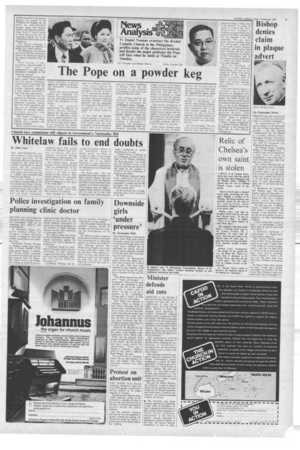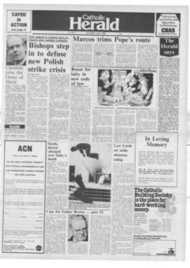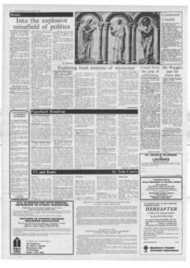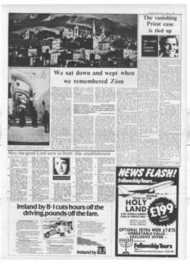Page 3, 13th February 1981
Page 3

Report an error
Noticed an error on this page?If you've noticed an error in this article please click here to report it.
Tags
Share
Related articles
A Report On The Islands That The Pope Will Visit This Month
Danger And Challenge Greet Pope In Far East Tour
Asia
Vatican Plays Down Death Plot
4 Million Flock To Hear Pone
The Pope on a powder keg
POPE John Paul II will arrive in Manila, the capital of the Philippines on Tuesday. He will meet an impoverished polyglot nation with Muslim. Chinese and Spanish underpinnings. Nearly 47 million people of whom about 85 per cent are nominally Catholic live on the 7,000 islands which make up the Philippines.
The official language is Tagalog-English but Spanish is spoken by a small minority.
The Philippines were handed over to the US after centuries of rule by the Spaniards following the Spanish-American War in 1898.
They became a selfgoverning commonwealth in 1 9 3 5 and achieved independence in 1946 with a constitution modelled on the American example. The Philippines are the only Asian country where Christians ;ire in the majority. Christianity arrived as part of a package deal with colonialism. For the Catholic Spaniards adherence to their religion and loyalty to their king were synonymous.
Since it.s liberation from the Japanese by McArthur's troops the islands have enjoyed impressive economic growth but most of the population still ekes out an existence made difficult by rampant disease, grinding poverty and widespread illiteracy.
The country is seated on a powder keg with the Pope walking into a political and religious minefield.
Much of the country's deep seated resentment is directed against the regime of 63-yearold President Ferdinand. Marcos.
Seven years ago he imposed martial law suspending civil liberties. These restrictions have only just been lifted and signs of unrest are breaking to the surface.
The one possible opposition to Marco is former Senator Benigno Aquino. He has only recently finished an eight-year prison term as a political prisoner. Last spring he was allowed to visit the US for open heart surgery. It was successful, but Aquino remains in America and is once again on a Marcos arrest list.
The power behind the "throne" is Imelda Marcos. the president's wife. She is Governor of metropolitan Manila, a cabinet minister. and an elected member of the interim National Assembly. Dubbed The Iron Butterfly" she has progressed from being Miss Manila 1953 to recognition as one of the world's ten richest women in 1972.
A few years ago Imelda Marcos planned to construct a 14 chapel basilica at the cost of 5100 million and was only persuaded to drop the grandiose project after severe criticism from the Cardinal Archbishop of Manila, Jaime Sin. He protested at the wasteful extravagance in the face of the horror of Manila's slums.
The Christian churches are important elements in the struggle to determine the archipelago's future. Though a few of the wealthier Christians. both lay and clerical. are part of the establishment which strongly supports Marcos the vast majority are politically inert. That is due to the long tradition of paternalism — patronage and manipulation which characterised both the bourgeois controlled Filipino
politics Lind parts of the Filipino Catholic Church before Vatican Council II. What direction this inert mass will take when it ignites will depend. to a large extent. upon how the majority in the small core of concerned and committed Christians act.
The previous Archbishop of Manila was Cardinal Santos, a diminutive aristocrat who worked hand in glove with the regime. Cardinal Sin is young and progressive. He jokes about the incongruity of his surname, is socially. conscious, and is a constant fighter for the poor.
Most Filipino Bishops stand aloof from the fray or behind Marcos. On the other side of the spectrum is Cardinal Julio Rosales, Archbishop of Cebu. He supports the regime under the guise of national security.
Francisco (layer S. .1. is Bishop of Macalbalay. An intense pipe-smoking progressive. he wants the Church to be more outspoken. One of the most frequent targets of his attacks is the Catholic hierarchy. He believes there is a wide gap between what many bishops preach and what they practice.
He once remarked: "We can come up with something on a national level but the more
important thing is what is done in the dioceses. Too many are afraid of rocking the boat." Bishop Claver continues to champion the poor and has little patience for fellow churchmen who are reluctant to act He explained: We can worry about relatively piddling things like clerical garb, communion in the hands. correct liturgical vestments and gestures and other minutiae. but not unjust wages. government by decree. farcical referendums, lack of due process. torture of prisoners — events that affect people's lives more intensely."
But the theology of Liberation. a Latin American phenomenon, has not as yet caught on. There is no native theologian of the calibre of Brazil's Leonardo Buff or Peru's Gustavo Gutierrez. There is a vocation shortage. and celibacy is a severe problem.
Pope John Paul II enjoyed a triumphal visit to Brazil. However, the Philippines does not have the united hierarchy of Brazil. The Polish Pontiff will have his work cut out for him as he makes his first visit to the Far East. It was in the Philippines that Pope Paul VI almost lost his life at the hands of a demented Bolivian painter. The Philippines is a mostly Catholic country. mired in mindless misery and governed by a "Catholic" despot complicated by a divided Catholic Bishop's Conference. It will present the Pope with his most difficult challenge yet.
blog comments powered by Disqus











